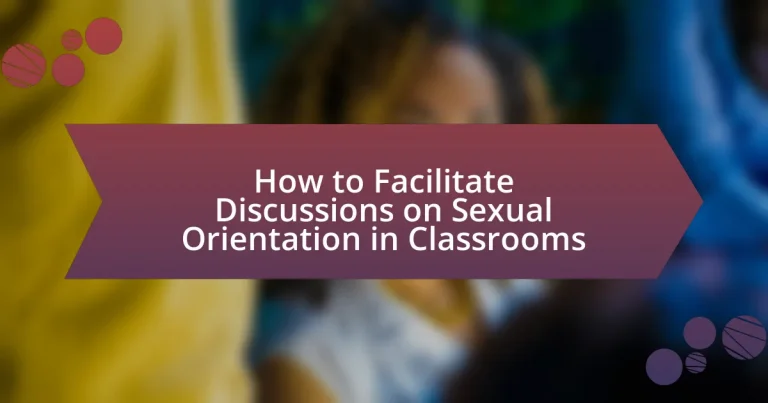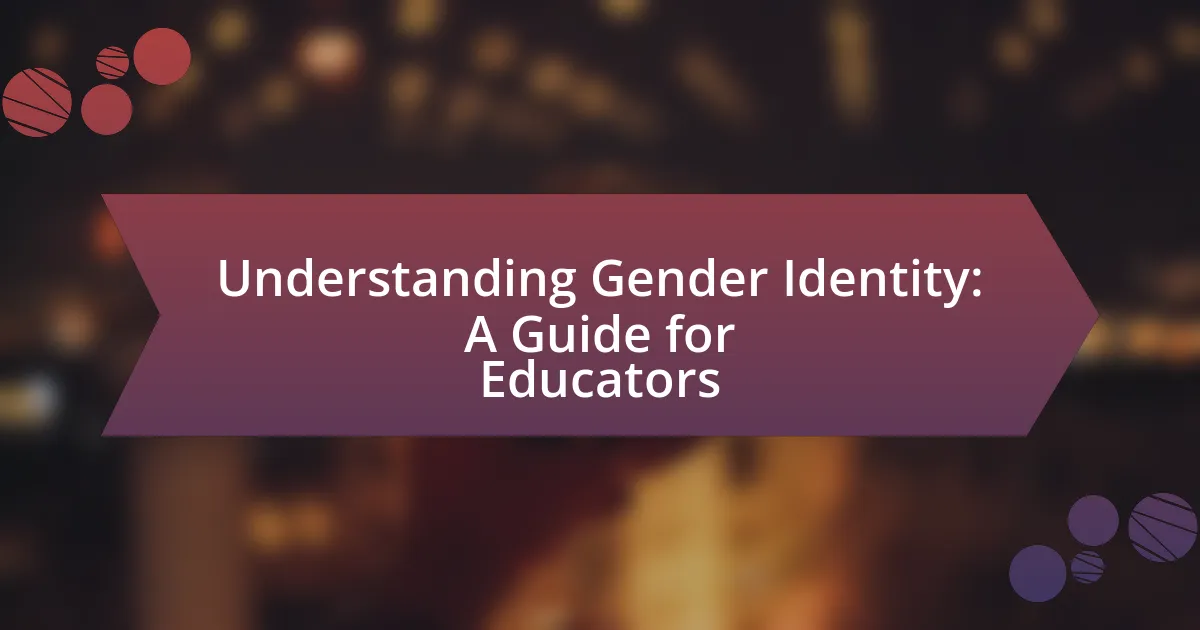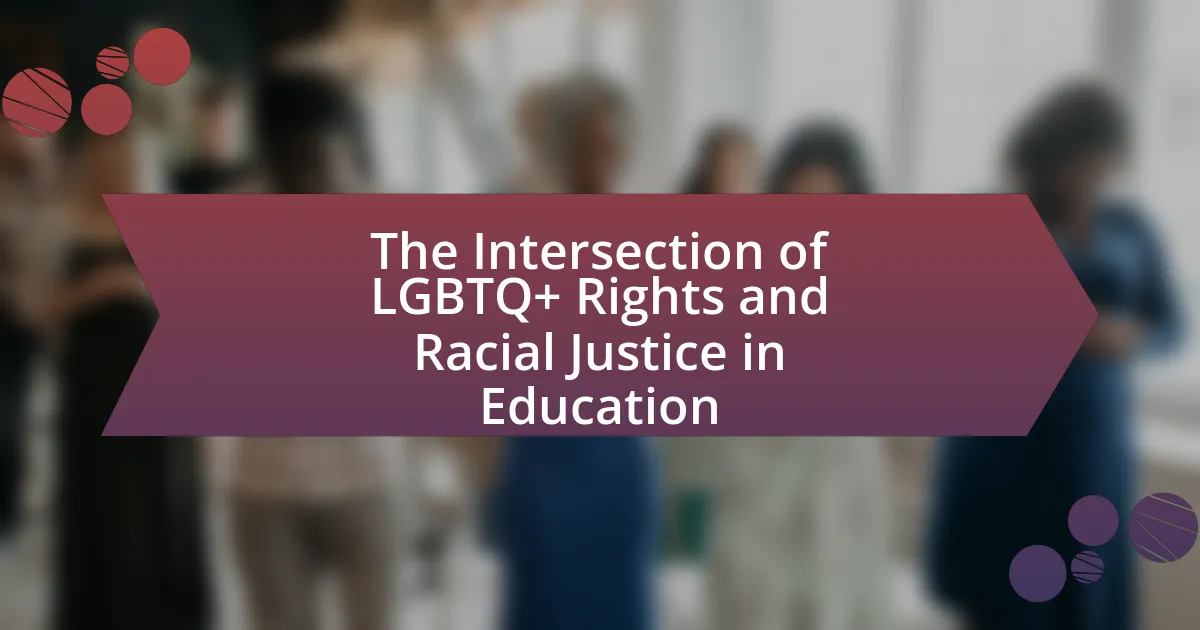The article focuses on effective strategies for facilitating discussions on sexual orientation in classrooms, emphasizing the importance of creating a safe and inclusive environment. Key considerations include establishing ground rules for respectful dialogue, using inclusive language, and addressing misconceptions. It highlights the role of educators in fostering student comfort and safety, as well as the impact of inclusive curricula on student well-being and academic performance. Additionally, the article outlines practical tips for engaging students, assessing their understanding, and utilizing resources to support these discussions, ultimately aiming to promote inclusivity and diversity in educational settings.

What are the key considerations for facilitating discussions on sexual orientation in classrooms?
Key considerations for facilitating discussions on sexual orientation in classrooms include creating a safe and inclusive environment, ensuring accurate and respectful language, and being aware of diverse perspectives. Establishing ground rules for respectful dialogue helps students feel secure in expressing their views. Using inclusive language acknowledges the spectrum of sexual orientations and fosters understanding. Additionally, educators should be prepared to address misconceptions and provide factual information, as studies show that inclusive education can reduce bullying and improve mental health outcomes for LGBTQ+ students.
How can educators create a safe environment for these discussions?
Educators can create a safe environment for discussions on sexual orientation by establishing clear ground rules that promote respect and confidentiality. This approach encourages students to express their thoughts without fear of judgment or backlash. Research indicates that classrooms with established norms for respectful dialogue see increased participation and reduced anxiety among students (Dewey, 1933). Additionally, educators should actively model inclusive language and demonstrate openness to diverse perspectives, which fosters a culture of acceptance. By integrating these practices, educators can effectively support a safe space for meaningful discussions on sexual orientation.
What strategies can be employed to ensure student comfort and safety?
To ensure student comfort and safety during discussions on sexual orientation in classrooms, educators can implement inclusive policies and create a supportive environment. Establishing clear guidelines for respectful communication fosters a safe space where students feel valued and heard. Training teachers in cultural competency and sensitivity equips them to handle diverse perspectives and potential conflicts effectively. Additionally, providing resources such as counseling services and support groups can help students navigate their feelings and experiences related to sexual orientation. Research indicates that schools with inclusive practices report higher levels of student well-being and lower instances of bullying, reinforcing the importance of these strategies.
How can ground rules be established for respectful dialogue?
Ground rules for respectful dialogue can be established by collaboratively creating a set of guidelines that all participants agree to follow. This process typically involves engaging all participants in a discussion about what behaviors and attitudes contribute to a respectful environment, such as active listening, avoiding interruptions, and using inclusive language. Research indicates that when participants co-create these rules, they are more likely to adhere to them, fostering a sense of ownership and accountability. For example, a study by the National Education Association highlights that classrooms with established norms for respectful communication see improved student engagement and reduced conflict.
Why is it important to address sexual orientation in educational settings?
Addressing sexual orientation in educational settings is crucial for fostering an inclusive and supportive environment for all students. By recognizing and validating diverse sexual orientations, educational institutions can reduce stigma and discrimination, which are linked to negative mental health outcomes among LGBTQ+ youth. Research indicates that schools that implement inclusive policies and curricula see improved academic performance and well-being among students, as highlighted in the 2019 GLSEN National School Climate Survey, which found that LGBTQ+ students who experienced supportive school environments reported lower rates of bullying and higher levels of academic achievement.
What impact does discussing sexual orientation have on student well-being?
Discussing sexual orientation positively impacts student well-being by fostering an inclusive environment that reduces stigma and promotes acceptance. Research indicates that when students engage in conversations about sexual orientation, they experience lower levels of anxiety and depression, as well as increased feelings of safety and belonging. A study published in the Journal of School Psychology found that LGBTQ+ students who attended schools with inclusive curricula reported higher self-esteem and lower rates of bullying. This evidence underscores the importance of open discussions about sexual orientation in enhancing overall student mental health and well-being.
How does this topic relate to inclusivity and diversity in education?
Facilitating discussions on sexual orientation in classrooms directly promotes inclusivity and diversity in education by creating a safe space for all students to express their identities and experiences. This approach acknowledges the varied backgrounds and perspectives of students, fostering an environment where differences are respected and valued. Research indicates that inclusive educational practices, such as open discussions about sexual orientation, can lead to improved academic outcomes and emotional well-being for LGBTQ+ students, as highlighted in the 2016 report by GLSEN, which found that schools with inclusive curricula have lower rates of bullying and higher levels of student engagement.
What challenges might educators face when facilitating these discussions?
Educators may face several challenges when facilitating discussions on sexual orientation in classrooms, including resistance from students, lack of training, and potential backlash from parents or the community. Resistance from students can manifest as discomfort or hostility, making it difficult to create an open dialogue. A lack of training can leave educators unprepared to address sensitive topics effectively, leading to misinformation or avoidance of critical issues. Additionally, potential backlash from parents or the community can create a hostile environment for educators, discouraging them from engaging in these important discussions. These challenges highlight the need for comprehensive training and support systems for educators to navigate sensitive topics effectively.
How can educators prepare for potential pushback from students or parents?
Educators can prepare for potential pushback from students or parents by establishing clear communication channels and fostering an inclusive classroom environment. By proactively sharing the curriculum and its objectives with stakeholders, educators can address concerns before they escalate. Research indicates that transparency in educational practices reduces resistance; for instance, a study by the National Education Association found that involving parents in discussions about sensitive topics leads to greater acceptance and understanding. Additionally, educators should be equipped with data and resources to support their teaching, which can help mitigate objections and reinforce the importance of discussing sexual orientation in a respectful and educational manner.
What resources are available to help educators navigate difficult conversations?
Educators can utilize resources such as the Human Rights Campaign’s “Welcoming Schools” program, which provides comprehensive training and materials to facilitate discussions on sexual orientation and gender identity. This program includes lesson plans, professional development workshops, and guidance on creating inclusive environments. Additionally, the “Teaching Tolerance” project by the Southern Poverty Law Center offers educational resources that help educators address sensitive topics, including sexual orientation, through lesson plans and classroom activities designed to promote understanding and respect. These resources are validated by their widespread use in educational settings and positive feedback from educators who have implemented them.
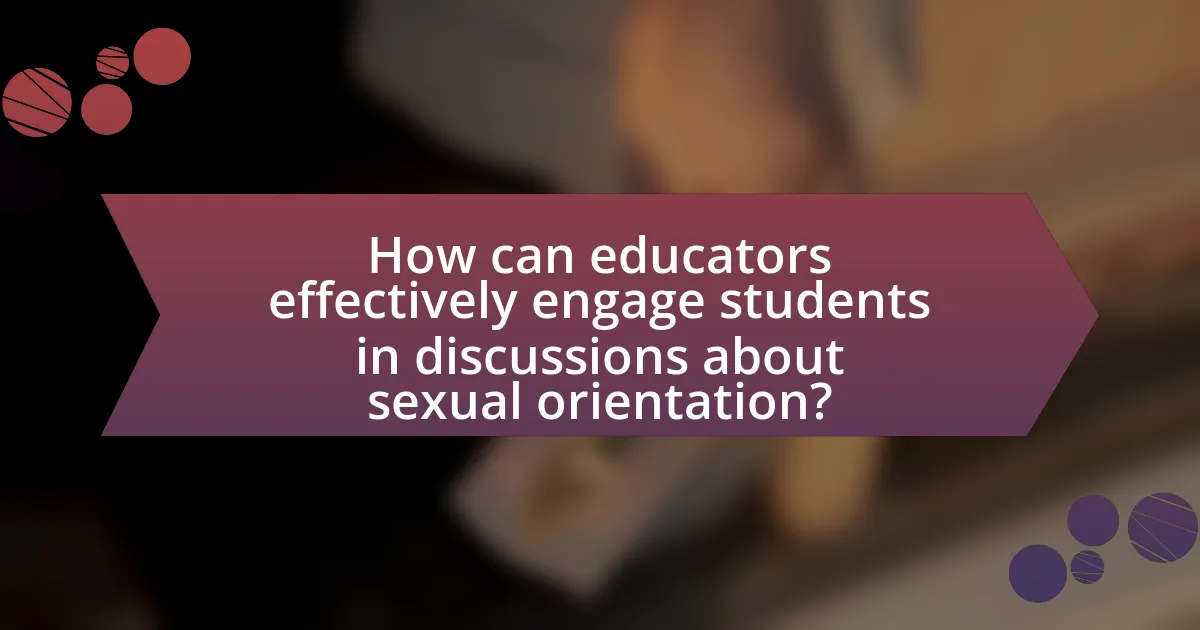
How can educators effectively engage students in discussions about sexual orientation?
Educators can effectively engage students in discussions about sexual orientation by creating a safe and inclusive environment that encourages open dialogue. Establishing ground rules for respect and confidentiality fosters trust among students, allowing them to express their thoughts and feelings without fear of judgment. Research indicates that inclusive curricula, which incorporate diverse perspectives on sexual orientation, enhance student engagement and understanding. For instance, a study published in the Journal of LGBT Youth found that when educators address sexual orientation openly, students report feeling more accepted and supported, leading to increased participation in discussions.
What techniques can be used to encourage student participation?
Techniques to encourage student participation include creating a safe and inclusive environment, using interactive activities, and implementing structured discussions. A safe and inclusive environment allows students to express their thoughts without fear of judgment, which is crucial when discussing sensitive topics like sexual orientation. Interactive activities, such as role-playing or group projects, engage students actively and foster collaboration. Structured discussions, guided by open-ended questions, promote critical thinking and ensure that all voices are heard. Research indicates that classrooms that employ these techniques see increased engagement and participation, leading to more meaningful discussions (Freeman et al., 2014, “Active Learning Increases Student Performance in Science, Engineering, and Mathematics,” Proceedings of the National Academy of Sciences).
How can open-ended questions foster deeper conversations?
Open-ended questions foster deeper conversations by encouraging participants to elaborate on their thoughts and feelings, rather than providing simple yes or no answers. This type of questioning invites individuals to share personal experiences and perspectives, which can lead to a more meaningful exchange of ideas. Research indicates that open-ended questions promote critical thinking and reflection, allowing for a richer dialogue. For instance, a study published in the Journal of Educational Psychology found that students engaged in discussions using open-ended questions demonstrated higher levels of engagement and understanding of complex topics, including sensitive subjects like sexual orientation.
What role do group activities play in facilitating discussions?
Group activities play a crucial role in facilitating discussions by promoting collaboration and encouraging diverse perspectives. These activities create an interactive environment where participants feel more comfortable sharing their thoughts and experiences, which is particularly important when discussing sensitive topics like sexual orientation. Research indicates that group discussions can enhance understanding and empathy among participants, as they allow individuals to hear different viewpoints and engage in meaningful dialogue. For instance, a study published in the Journal of Educational Psychology found that cooperative learning strategies, which often involve group activities, significantly improve students’ engagement and willingness to discuss complex issues.
How can educators address misconceptions about sexual orientation?
Educators can address misconceptions about sexual orientation by implementing inclusive curricula that accurately represent diverse sexual orientations and identities. This approach involves integrating comprehensive sex education that includes discussions on sexual orientation, utilizing age-appropriate resources, and fostering an open environment where students feel safe to ask questions. Research indicates that inclusive education can reduce bullying and discrimination; for instance, a study by GLSEN found that LGBTQ-inclusive curricula lead to a more positive school climate and improved mental health outcomes for LGBTQ students. By actively challenging stereotypes and providing factual information, educators can effectively dispel myths and promote understanding among students.
What common myths should be debunked during discussions?
Common myths that should be debunked during discussions on sexual orientation include the belief that sexual orientation is a choice, the idea that LGBTQ+ individuals are inherently promiscuous, and the misconception that being LGBTQ+ is a mental disorder. Research from the American Psychological Association indicates that sexual orientation is not a choice but rather a complex interplay of biological, environmental, and social factors. Additionally, studies show that LGBTQ+ individuals are no more promiscuous than their heterosexual counterparts, and the World Health Organization has affirmed that being LGBTQ+ is not a mental disorder, emphasizing the importance of understanding these facts to foster respectful and informed discussions.
How can factual information be presented effectively?
Factual information can be presented effectively by using clear, concise language and structured formats such as bullet points or tables. This approach enhances comprehension and retention, as studies show that organized information is easier for individuals to process. For instance, the use of visual aids like charts or infographics can significantly improve understanding, as they allow learners to visualize relationships and data. Additionally, incorporating real-life examples or case studies can contextualize the information, making it more relatable and impactful for the audience.
What role does curriculum play in discussions about sexual orientation?
Curriculum plays a critical role in discussions about sexual orientation by providing structured content that promotes understanding and acceptance. A well-designed curriculum can include diverse perspectives on sexual orientation, fostering an inclusive environment that encourages open dialogue among students. Research indicates that inclusive curricula can reduce bullying and discrimination, as evidenced by a study published in the Journal of School Health, which found that schools implementing comprehensive sexual education programs saw a significant decrease in harassment based on sexual orientation. Thus, the curriculum serves as a foundational tool for educators to address and normalize discussions about sexual orientation in classrooms.
How can educators integrate sexual orientation topics into existing curricula?
Educators can integrate sexual orientation topics into existing curricula by incorporating inclusive literature, diverse historical perspectives, and relevant current events into lessons. For instance, using texts that feature LGBTQ+ characters or authors can foster discussions about identity and representation. Research indicates that inclusive curricula positively impact students’ understanding and acceptance of diverse sexual orientations, as shown in studies like “The Impact of LGBTQ Inclusive Curriculum on Student Outcomes” by GLSEN, which found that students in inclusive environments reported feeling safer and more supported. Additionally, educators can create assignments that encourage critical thinking about societal norms and biases related to sexual orientation, further embedding these discussions into the educational framework.
What resources are available for developing inclusive lesson plans?
Resources available for developing inclusive lesson plans include educational websites, professional development workshops, and curriculum guides specifically designed for diversity and inclusion. Websites such as Teaching Tolerance and the Human Rights Campaign provide lesson plans and resources that address sexual orientation and gender identity, ensuring educators can create a supportive environment. Additionally, workshops offered by organizations like GLSEN (Gay, Lesbian & Straight Education Network) equip teachers with strategies to facilitate discussions on sexual orientation effectively. Curriculum guides from reputable educational publishers often include sections on inclusivity, providing concrete examples and activities that promote understanding and respect among students.
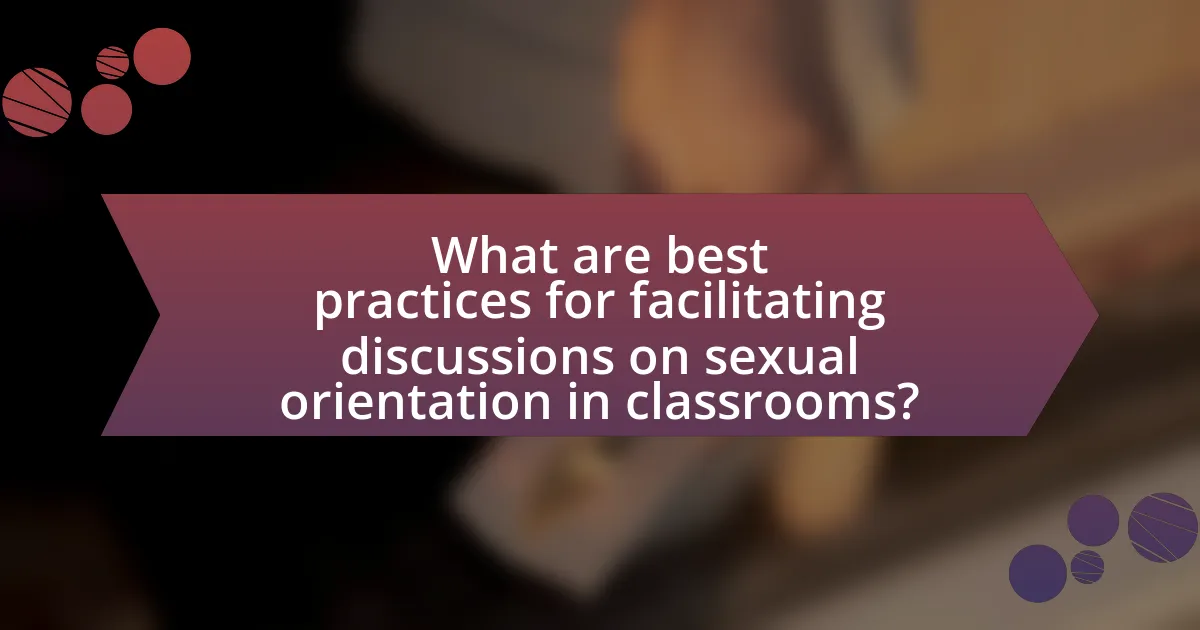
What are best practices for facilitating discussions on sexual orientation in classrooms?
Best practices for facilitating discussions on sexual orientation in classrooms include creating a safe and inclusive environment, using appropriate language, and encouraging open dialogue. Establishing ground rules for respect and confidentiality helps students feel secure in sharing their thoughts. Educators should use inclusive language that acknowledges diverse sexual orientations and avoid assumptions about students’ identities. Additionally, incorporating diverse perspectives through literature, media, and guest speakers can enrich discussions. Research indicates that inclusive curricula positively impact students’ understanding and acceptance of sexual orientation, fostering a more supportive classroom atmosphere.
How can educators assess student understanding and attitudes towards sexual orientation?
Educators can assess student understanding and attitudes towards sexual orientation through surveys, discussions, and reflective writing assignments. Surveys can include questions that gauge knowledge and personal beliefs about sexual orientation, allowing educators to quantify attitudes and identify misconceptions. Classroom discussions provide opportunities for students to express their views and engage with diverse perspectives, enabling educators to observe and evaluate student understanding in real-time. Reflective writing assignments encourage students to articulate their thoughts and feelings about sexual orientation, offering deeper insights into their attitudes. Research indicates that these methods can effectively reveal students’ knowledge gaps and biases, facilitating targeted educational interventions.
What assessment tools can be used to gauge student perspectives?
Surveys and questionnaires are effective assessment tools to gauge student perspectives. These tools can be designed to include Likert scale questions, open-ended responses, and demographic information, allowing educators to collect quantitative and qualitative data on students’ views regarding sexual orientation discussions. Research indicates that using anonymous surveys can encourage honest feedback, as students may feel more comfortable sharing their true opinions without fear of judgment. For instance, a study published in the Journal of Educational Psychology found that anonymous surveys increased response rates and the authenticity of student feedback, thereby providing educators with valuable insights into student perspectives.
How can feedback be utilized to improve future discussions?
Feedback can be utilized to improve future discussions by identifying areas of misunderstanding and enhancing participant engagement. When educators collect feedback from students after discussions on sexual orientation, they can pinpoint specific topics that may have caused confusion or discomfort. For instance, a study by the Human Rights Campaign found that inclusive discussions lead to higher student engagement and understanding when feedback is actively sought and implemented. By analyzing this feedback, educators can adjust their teaching strategies, create a more inclusive environment, and ensure that future discussions are more effective and sensitive to students’ needs.
What ongoing professional development opportunities exist for educators?
Ongoing professional development opportunities for educators include workshops, online courses, and conferences focused on inclusive teaching practices. These opportunities often cover topics such as sexual orientation, diversity, and equity in education. For instance, organizations like the Human Rights Campaign and GLSEN offer training sessions specifically designed to equip educators with the skills to facilitate discussions on sexual orientation in classrooms. Research indicates that educators who participate in such professional development are more effective in creating inclusive environments, as highlighted in studies published by the American Educational Research Association.
How can workshops and training enhance educators’ skills in this area?
Workshops and training can significantly enhance educators’ skills in facilitating discussions on sexual orientation in classrooms by providing them with targeted strategies and resources. These professional development opportunities equip educators with knowledge about diverse sexual orientations, fostering an inclusive environment. Research indicates that educators who participate in specialized training are more confident in addressing sensitive topics, which leads to improved student engagement and understanding. For instance, a study published in the Journal of LGBT Youth found that teachers who received training on LGBTQ+ issues reported a 40% increase in their comfort level when discussing these topics in class. This evidence underscores the effectiveness of workshops and training in empowering educators to create safe and supportive learning environments for all students.
What organizations provide support and resources for educators on this topic?
Organizations that provide support and resources for educators on facilitating discussions on sexual orientation in classrooms include the Human Rights Campaign (HRC), GLSEN (Gay, Lesbian & Straight Education Network), and the Trevor Project. The Human Rights Campaign offers educational resources and training programs aimed at creating inclusive environments for LGBTQ+ students. GLSEN provides lesson plans, guides, and professional development specifically designed to help educators address sexual orientation and gender identity in their classrooms. The Trevor Project focuses on crisis intervention and suicide prevention for LGBTQ+ youth, offering resources that educators can use to support students effectively. These organizations are recognized for their commitment to promoting understanding and acceptance of sexual orientation in educational settings.
What practical tips can educators implement for successful discussions?
Educators can implement structured guidelines to facilitate successful discussions on sexual orientation in classrooms. Establishing ground rules for respectful dialogue encourages a safe environment where students feel comfortable sharing their thoughts. Additionally, using open-ended questions promotes critical thinking and allows for diverse perspectives to emerge. Incorporating diverse materials, such as literature and media that reflect various sexual orientations, can enhance understanding and empathy among students. Research indicates that classrooms that foster inclusive discussions lead to improved student engagement and a greater sense of belonging, as highlighted in the study “Creating Safe Spaces: The Role of Educators in Supporting LGBTQ+ Youth” by GLSEN.
How can educators prepare themselves emotionally for these discussions?
Educators can prepare themselves emotionally for discussions on sexual orientation by engaging in self-reflection and seeking professional development opportunities. Self-reflection allows educators to understand their own biases and emotional responses, which is crucial for creating a safe environment for students. Professional development, such as workshops focused on LGBTQ+ issues, equips educators with the knowledge and skills necessary to handle sensitive topics effectively. Research indicates that educators who participate in training programs report increased confidence and reduced anxiety when discussing sexual orientation, leading to more productive classroom discussions.
What are some effective ways to follow up after discussions on sexual orientation?
Effective ways to follow up after discussions on sexual orientation include creating a safe space for continued dialogue, providing additional resources for students, and encouraging reflection through written feedback. Establishing a safe environment allows students to express their thoughts and feelings without fear of judgment, which is crucial for ongoing conversations about sensitive topics. Providing resources, such as articles or support groups, helps students explore the subject further and reinforces the importance of understanding diverse perspectives. Encouraging written feedback allows students to articulate their thoughts and questions, fostering deeper engagement with the topic. These methods are supported by educational research indicating that ongoing dialogue and resource availability enhance understanding and acceptance of diverse sexual orientations in educational settings.
